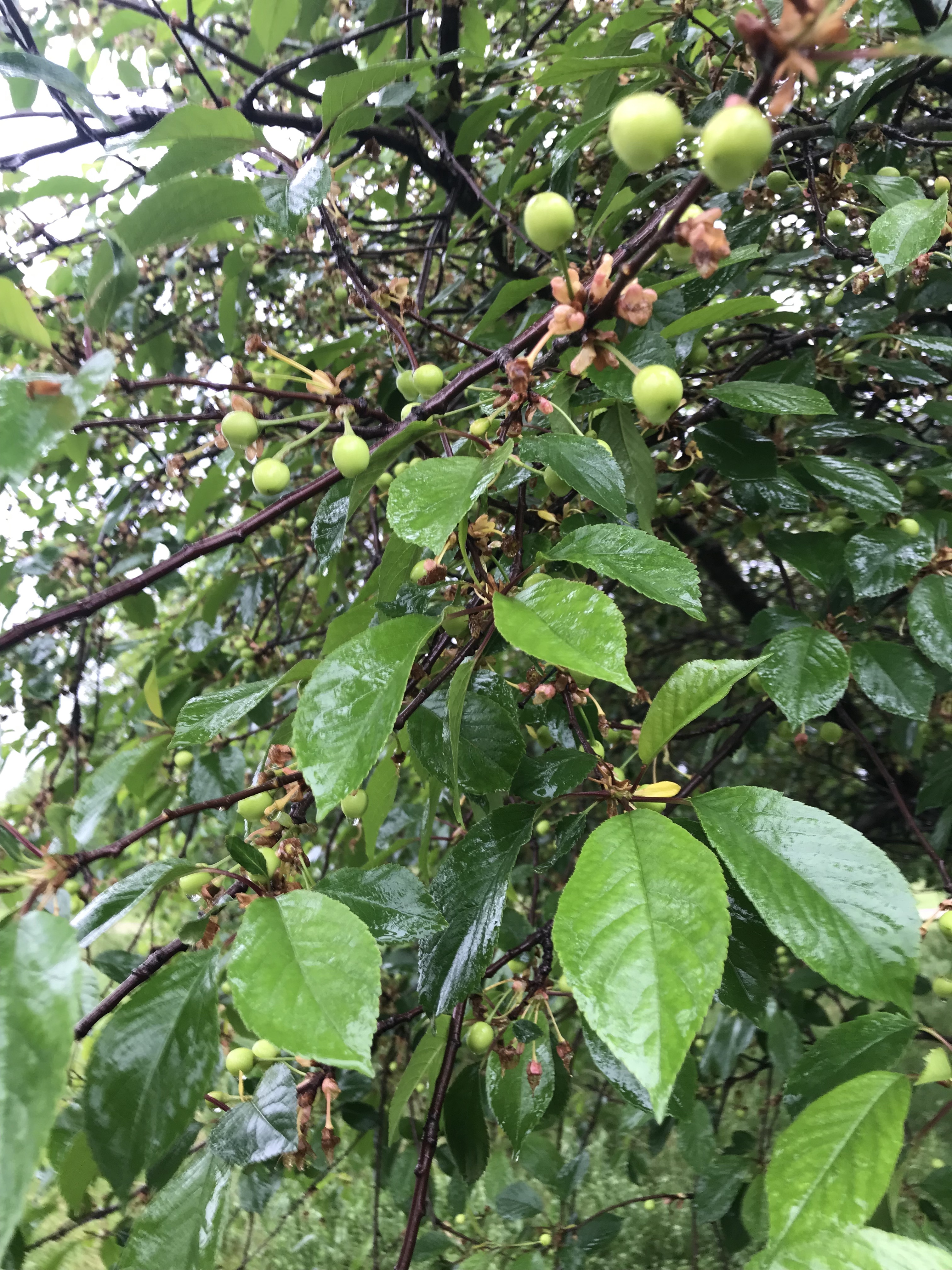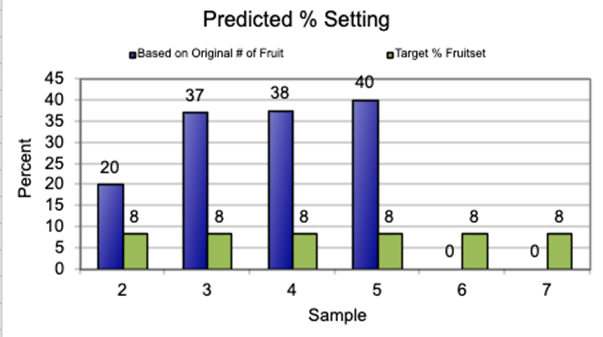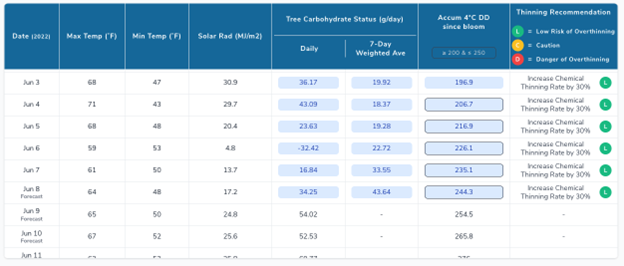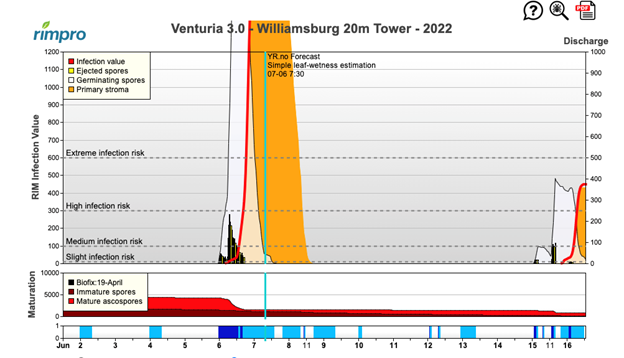Northwest Michigan fruit update – June 7, 2022
The region received significant much needed rain, and all tree fruit have sized considerably in the last week.

Weather report
The forecast is predicting rain to move out of the area, and we will see fog over the region until mid-afternoon. We are expected to have a partly sunny day here in the west with lingering showers in the eastern part of the state. We will continue to see cloudy and cool conditions through Wednesday, June 8, but we will see a mostly sunny and dry Thursday, but rain moving back into the region in the southern part of the state on Friday. The weekend is predicted to be fair and dry. Overnight temperatures are predicted to be cool, perhaps dropping into the low 40s in our region.
The 6-10 day forecast is showing that the ridge to the west will flatten, and we will see a change from this recent wet weather to a more dry period. Michigan will begin to warm in this next period, as early as next week. By Tuesday, June 14, temperatures will start to reach into the 70s to 80s and will be slightly warmer than normal. The medium term forecast for the north will be a bit wetter than normal compared to the southern part of Michigan.
We have accumulated 759 growing degree days (GDD) base 42 and 424 GDD base 50 for the Northwest Michigan Horticulture Research Center (NWMHRC). Our 33-plus year average is 740GDD base 42 and 387GDD base 50. The warm weather earlier in the season kicked up our GDD base 50 to higher than our average. The most notable weather pattern change has been the rain we received on June 5-6, which was much needed after a noticeable dry May. The region’s rainfall totals can be seen in Table 1; rainfall was variable across the northwest, but all stations received some rain.
|
Table 1. Rainfall totals for northwest Michigan for June 5-6, 2022. |
|
|
Benzonia |
1.43 |
|
East Leland |
0.83 |
|
Eastport |
0.99 |
|
Elk Rapids |
1.04 |
|
Kewadin |
0.7 |
|
Northport |
0.46 |
|
Old Mission |
1.26 |
|
Onekama Twp/Bear Lake |
1.53 |
|
Petoskey |
0.92 |
|
NWMHRC |
1 |
|
Williamsburg |
1.04 |
Crop report
The crop has sized considerably since last week. Gala have sized from 9mm last week to 14mm this week. Honeycrisp gained from 6mm to 10-16mm in this last week. Montmorency and Balaton have sized from 10mm to 12mm. All sweet cherry varieties have increased by 1mm in size.

Many growers are starting to assess their crops at this time. According to MSU colleagues in southwest Michigan, the tart cherry crop looks good. In fact, the team has commented that most of the tree fruit crops look good in that region. The Michigan Cherry Committee estimates the crop in southwest to be 24 million pounds. The west central tart cherry crop is coming along, and the Michigan Cherry Committee estimate their crop is somewhere between 50-60 million pounds. The Michigan Cherry Committee estimate for northwest more variable depending on the location as some areas look like they have a bigger crop than others. At this point, which is still early, the Michigan Cherry Committee members estimate the tart cherry crop to be somewhere between 100-130 million pounds. We have observed the crop to be variable by tree but not too much by location. We have trees at the station with a good crop and some with a light crop.
We have five to seven leaves out at the NWMHRC. This timing is excellent for Pro-Gibb applications. However, Pro-Gibb, like other PGR materials, work better at warmer temperatures, growers should wait to apply this material when the temperatures increase, even if the leaves are further expanded than this recommendation. For a review article, see “Gibberellic acid applications in cherries” from Michigan State University Extension.
There are many questions about the apple crop. The current consensus about the crop is that it’s variable by tree/block/variety here in northwest Michigan. Earlier in the season, we heard reports about the variability in return bloom in Honeycrisp, particularly young blocks. We are now starting to hear about different amounts of set in many varieties. At this time, Gala is the most consistent setting variety here in the north. Reports of variability in blocks are also coming in from the Grand Rapids area. Thinning will also play a big role in the size of the crop. We have had cool conditions, which are not optimal for thinning.
Growers have reported that fruit has been slow to drop, and the current forecast does not look like it will warm for another thinning application. We are at 14mm to 16mm in size at the NWMHRC, and this size is approaching a period where apples are harder to thin. We have been using precision crop management techniques on our blocks to determine if our last week’s thinning applications were effective. The current data show that our first thinner application on 2 June was not effective as of yet (Photo 3). It has only been five days since the application, and with the cool weather, we may have to be patient to see if more fruit come off. We will likely add another thinning application when the weather warms this week. The carbohydrate model is also showing that there is a surplus in carbohydrates, and fruit will be much harder to thin (Photo 4).


Pest and disease report
Pests
In general, timing applications for pests has been difficult with the swings in weather. Insect activity increases in warm weather and decreases when temperatures cool. Our trap counts reflect these changes in temperatures and setting biofix or applying insecticides at peak flight will be a challenge.
San Jose scale. We caught an average of 13.3 male San Jose scale this week, which is about half of the males we captured last week. However, we are conducting a small efficacy trial in apples for control of San Jose scale, and we caught an average of 149 males in eight traps on June 2. In that block, we considered that increase in San Jose scale peak male flight and applied our insecticide treatments. This cool weather will slow activity, and our flights will likely decrease.
Lesser peach tree borer. We caught an average of 16.7 lesser peach tree borer moths this week. This number is doubled from last week when we only caught an average of seven moths. Peak flight of lesser peach tree borer in our region is typically mid-June. Growers need to remember that Lorsban is not an insecticide for trunk sprays unless it is a non-bearing block.
American plum borer. We caught an average of four APB moths this week, which is relatively unchanged from the previous week.
Black stem borer. We caught an average of one black stem borer again this week. However, we have heard reports and observed tree death from black stem borer this spring. Despite our low numbers at the NWMRHC, these pests must have flown during the heat a few weeks ago and have started to bore into trees.
Codling moth. We caught an average of 1.3 codling moth. With this cool weather, codling moth flight will decline. Growers should monitor blocks as this pest is regional in its habits. We caught codling moth in two weeks, but with numbers so low, we are not yet establishing biofix. Again, with the warm and cool weather fluctuations, it is difficult to know when to establish biofix. A refresher article about codling moth, its model, and cool weather can be read here: “Codling moths: Thinking about Enviro-weather model and hot and cold temperatures.”
Diseases
Cherry leaf spot. We have been scouting our unsprayed treatments for cherry leaf spot at the NWMHRC, and we have only found one lesion. Growers have likely been controlling cherry leaf spot well with the dry conditions, but growers need to treat for leaf spot after the last rain event.
Powdery mildew. There may have been an early jump on mildew this year with the warm and dry weather. We have done some work on powdery mildew, and we have found that the optimal timing for control is first or second cover; this cool weather should minimize powdery mildew infections.
Apple scab. Growers have also done a great job at keeping scab in check this season. The RIMpro model is predicting the next scab infection period around June 12-13 (Photo 4); the model is also showing that we still have mature spores around June 16, so we are not calling the end of primary scab in northwest Michigan. Southwest Michigan is close to calling the end of primary scab, and the Ridge spore numbers are minimal with the last rains. West central caught 50 spores per rod during this last rain.

RIMpro links:



 Print
Print Email
Email
